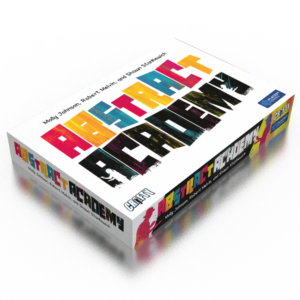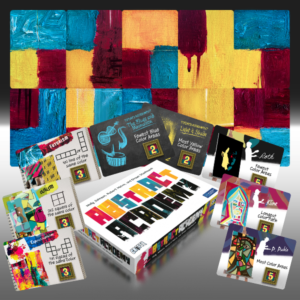
Abstract Academy
Abstract Academy is a card game designed by Molly Johnson, Robert Melvin, and Shawn Stankewich of Flatout Games and distributed by Crafty Games.
By Aaron T. Huss

Learn more about Abstract Academy here
Purchase Abstract Academy here <– Buy direct and get a free promo card!
Find other Crafty Games posts here
Abstract Academy has been provided by Crafty Games for review.
Abstract Academy is a fun, lighthearted card game for 2 or 4 players where you go around the table, building a work of abstract art in the hopes of scoring points according to specific criteria that must be met. It is a combination of strategy and luck-of-the-draw where you can bolster your points or potentially spoil the opponents. The game is played in three rounds with each round drawing upon a different combination of scoring criteria and taking turns to build the final masterpiece. Once the masterpiece is done, everyone counts the points they’ve earned within their scoring zone based on the scoring criteria for that round (hint – they’re based on colors and patterns). Pretty simple and straightforward.
 I played this game with three of my daughters (ages 5, 7, and 12) and we all had a lot of fun. However, our fun required a practice round to better understand how the scoring and card play worked, but after that we had it down perfectly and game play was actually quite quick. The game scales perfectly for a 4-player game, but unfortunately you cannot play with only 3. 2 or 4 yes, 3 or more than 4 no. But that’s okay as it fits with the design of the game. I can see creating some type of expansion for other player configurations, but we won’t dwell on that.
I played this game with three of my daughters (ages 5, 7, and 12) and we all had a lot of fun. However, our fun required a practice round to better understand how the scoring and card play worked, but after that we had it down perfectly and game play was actually quite quick. The game scales perfectly for a 4-player game, but unfortunately you cannot play with only 3. 2 or 4 yes, 3 or more than 4 no. But that’s okay as it fits with the design of the game. I can see creating some type of expansion for other player configurations, but we won’t dwell on that.
The game has some fun replayability built in as the scoring criteria is based on the scoring cards you draw, which there are more than enough for a handful of games without having to shuffle. This breaks from the monotony of a game that becomes boring the more you play it as you have to change your strategy depending on how you score points. Especially since some of the scoring methods contradict each other and you have to choose which one you go for, because you may not get both.
There is one slight drawback to the game. Some of the cards that explain how you earn points contained verbiage that was a bit confusing and definitely not within the realm of the youngest rated ages (8+). We had a couple times where we ended up interpreting the criteria in our own way that made sense for us, and it worked the way we did it. Unfortunately I don’t know if we did it the right way though. This could be easily remedied with an FAQ on the website for those who get a little tripped up. Our preferred method of resolution was to determine what the card meant before we started playing cards to ensure we were playing toward the correct goal.
Other than that one slight drawback, I really liked the game. I find it a great game to play with friends and a really great game to play with your children. It’s not only fun to create these colored patterns to form an abstract masterpiece, but you don’t have to worry about your children having to read/understand/interpret a bunch of rules on a card every time it’s their turn. Just let them know what patterns to look for and their good to go!
